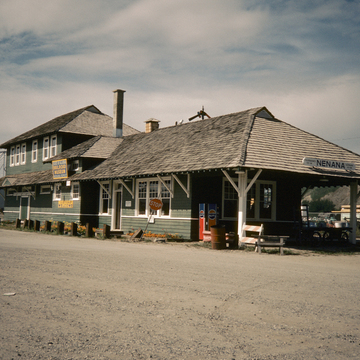Designed by the Alaska Engineering Commission, the depot at Nenana was constructed in 1922 by contractor Hartley Howard at a cost of $24,000. Based on the same design as the station in Seward, Nenana's was 4 feet longer at either end and a bit wider to accommodate more insulation. The overall dimensions are 98 feet by 24 feet, with a 30 foot wide section in the middle. The wood frame was covered with wide clapboards below the window sills and wood shingles above. The low hipped roof, hip-roofed dormers, wide overhangs supported by brackets, and exposed rafter ends are identified with the Craftsman style and stem ultimately from the stations that H. H. Richardson designed for small towns in New England four decades earlier.
The interior is finished with a pressed-tin ceiling and vertical board wainscoting. A slight change in plan from the Seward station provided for a hallway from the waiting room to baggage room, between the ticket agent's office on the track side and the bathrooms on the road side.
In 1937 a second story was added to the west end of the building to provide quarters for the station agent. The addition, clad with narrow clapboarding, is topped with a hipped roof. The station today is occupied by a museum and gift shop.

